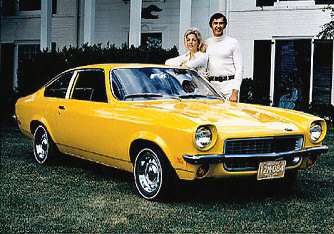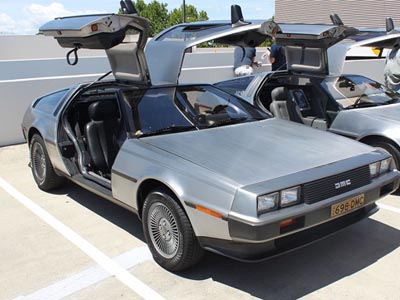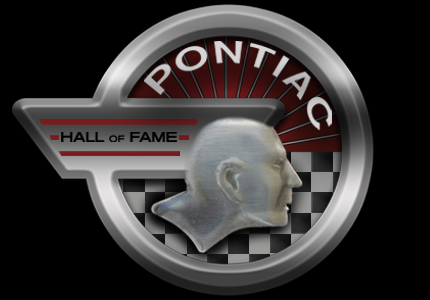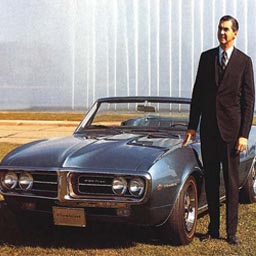John Delorean --- January 6, 1925 - March 19, 2005
Times Nominated: 1
Year Inducted: 2018
Nominated Year(s): 2018
Category: Pontiac Ambassador
Knudsen was the son of the former president of GM, William Knudsen, who was called away from his post to head the war mobilization production effort at the request of President Roosevelt.
Knudsen was also a MIT engineering graduate, and at 42 he was the youngest man to head a division of GM. DeLorean and Knudsen quickly became close friends, and DeLorean eventually cited Knudsen as a major influence and mentor. DeLorean's years of engineering at Pontiac were highly successful, producing dozens of patented innovations for the company, and in 1961 he was promoted to the position of division chief engineer.
DeLorean's most notable contribution to Pontiac was the Pontiac GTO (Gran Turismo Omologato), a muscle car named after the Ferrari 250 GTO. It evolved because of the internal GM ban on racing (January 1963) that ended the methodology which Pontiac had used to propel itself into the # 3 sales slot. Pontiac was forced to take its efforts off the track and put it on the street to maintain its # 3 position. The result was the GTO. The GTO debuted as a Tempest/LeMans option package with a larger, more powerful engine in 1964. This marked the beginning of Pontiac's renaissance as GM's performance division instead of its previous position as a slightly bigger Chevrolet with no clear brand identity.
From its launch in 1964, sales of the car and its popularity continued to grow dramatically in the following years. DeLorean received almost total credit for the success of the "first muscle car", singularly responsible for conceptualizing, engineering, and the marketing – becoming the singular golden boy of Pontiac, and was rewarded with his 1965 promotion to head the entire Pontiac division.
At the age of 40, DeLorean had broken the record for youngest division head at GM, and was determined to continue his string of successes. Adapting to the frustrations that he perceived in the executive offices was, however, a difficult transition for him. DeLorean believed there was an undue amount of infighting at GM between divisional heads, and several of Pontiac's advertising campaign themes met with internal resistance, such as the "Tiger" campaign used to promote the GTO and other Pontiac models in 1965 and 1966. One of the biggest disappointments for Pontiac was the GM's fourteenth floor's Ed Cole's decision to ban multiple carburetion. Multiple carburetion had been with Pontiac since 1956 starting with 2X4 bbls. and Pontiac's famous Tri-Power (3X2bbls.) since 1957. Ironically the only GM cars to escape this ban was Ed Cole's beloved Corvair and Corvette. There are scores of this conflict with Ed Cole that go way back to Bunkie Knudsen. The most memorable would be the 1964 GTO was supposed to be equipped with disc brakes which were even tooled for free by Kelsey Hayes, and radial tires were supposed to be offered but were killed by Cole as well.
In response to the "pony car" market dominated by the wildly successful Ford Mustang, DeLorean turned to the 14th Floor for permission to offer a smaller version of the Pontiac Banshee Show car for 1966. DeLorean's version was rejected because of GM's concern that his design would take away sales from the Corvette, their flagship performance vehicle, so instead they forced him to work with the existing Camaro design. He could only make changes to the front and rear of the car and even had to use the same fenders. Suspension was a whole different story as the Firebird has front and rear suspension differences compared to Camaro. The vehicle, the Pontiac Firebird, introduced for the 1967 model year became even more popular throughout the 70s.
Shortly after the Firebird's introduction, DeLorean turned his attention to development of an all-new Grand Prix, the division's personal luxury car based on the full sized Pontiac line since 1962. Sales were sagging by this time however, but the new for 1969 model would have its own distinct body shell with drivetrain and chassis components from the intermediate-sized Pontiac A-body (Tempest, LeMans, GTO). Delorean knew Pontiac Division couldn't finance the new car alone so Delorean went to his former boss Pete Estes and asked to share the cost of development with Pontiac having a one-year exclusivity before Chevrolet would release the 1970 Monte Carlo. The deal was done. The 1969 Pontiac Grand Prix looked a lot like a slightly scaled down Cadillac Eldorado with its razor-sharp bodylines and a 6-foot-long (1.8 m) hood. Inside was a sporty and luxurious interior highlighted by a wraparound cockpit-style instrument panel, bucket seats and center console. The new model offered a sportier, high performance, somewhat smaller and lower-priced alternative to the other personal luxury cars then on the market such as the Ford Thunderbird, Buick Riviera, Lincoln Continental Mark III, and Oldsmobile Toronado. The 1969 Grand Prix production ended up at over 112,000 units, far higher than the 32,000 1968 Grand Prix built from the full-sized Pontiac body.
During his time at Pontiac, DeLorean had begun to enjoy the freedom and celebrity that came with his position, and spent a good deal of his time traveling to locations around the world to support promotional events. His frequent public appearances helped to solidify his image as a "rebel" corporate businessman with his trendy dress style and casual banter.
Even as General Motors experienced revenue declines, Pontiac remained highly profitable under DeLorean, and despite his growing reputation as a corporate maverick, on February 15, 1969 he was again promoted. This time it was to head up the prestigious Chevrolet division, General Motors' flagship marque.
Later in the seventies, Delorean went on to form the Delorean Car company. However, he will always be rememembered as the guy that was largely responsible for the start of the Muscle Car Era.


John Delorean Acceptance Speech











